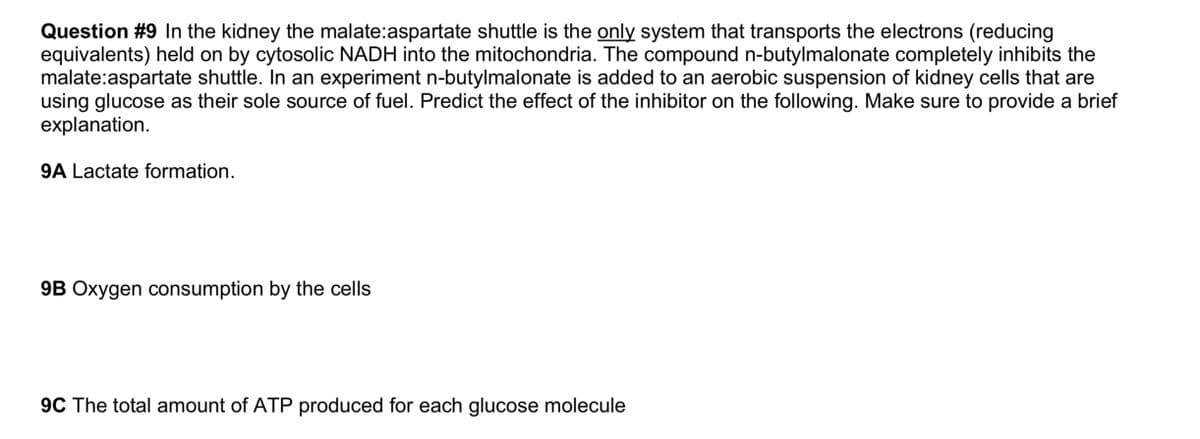Question #9 In the kidney the malate:aspartate shuttle is the only system that transports the electrons (reducing equivalents) held on by cytosolic NADH into the mitochondria. The compound n-butylmalonate completely inhibits the malate:aspartate shuttle. In an experiment n-butylmalonate is added to an aerobic suspension of kidney cells that are using glucose as their sole source of fuel. Predict the effect of the inhibitor on the following. Make sure to provide a brief explanation. 9A Lactate formation. 9B Oxygen consumption by the cells 9C The total amount of ATP produced for each glucose molecule
Question #9 In the kidney the malate:aspartate shuttle is the only system that transports the electrons (reducing equivalents) held on by cytosolic NADH into the mitochondria. The compound n-butylmalonate completely inhibits the malate:aspartate shuttle. In an experiment n-butylmalonate is added to an aerobic suspension of kidney cells that are using glucose as their sole source of fuel. Predict the effect of the inhibitor on the following. Make sure to provide a brief explanation. 9A Lactate formation. 9B Oxygen consumption by the cells 9C The total amount of ATP produced for each glucose molecule
Biochemistry
9th Edition
ISBN:9781319114671
Author:Lubert Stryer, Jeremy M. Berg, John L. Tymoczko, Gregory J. Gatto Jr.
Publisher:Lubert Stryer, Jeremy M. Berg, John L. Tymoczko, Gregory J. Gatto Jr.
Chapter1: Biochemistry: An Evolving Science
Section: Chapter Questions
Problem 1P
Related questions
Question

Transcribed Image Text:Question #9 In the kidney the malate:aspartate shuttle is the only system that transports the electrons (reducing
equivalents) held on by cytosolic NADH into the mitochondria. The compound n-butylmalonate completely inhibits the
malate:aspartate shuttle. In an experiment n-butylmalonate is added to an aerobic suspension of kidney cells that are
using glucose as their sole source of fuel. Predict the effect of the inhibitor on the following. Make sure to provide a brief
explanation.
9A Lactate formation.
9B Oxygen consumption by the cells
9C The total amount of ATP produced for each glucose molecule
Expert Solution
This question has been solved!
Explore an expertly crafted, step-by-step solution for a thorough understanding of key concepts.
Step by step
Solved in 2 steps

Recommended textbooks for you

Biochemistry
Biochemistry
ISBN:
9781319114671
Author:
Lubert Stryer, Jeremy M. Berg, John L. Tymoczko, Gregory J. Gatto Jr.
Publisher:
W. H. Freeman

Lehninger Principles of Biochemistry
Biochemistry
ISBN:
9781464126116
Author:
David L. Nelson, Michael M. Cox
Publisher:
W. H. Freeman

Fundamentals of Biochemistry: Life at the Molecul…
Biochemistry
ISBN:
9781118918401
Author:
Donald Voet, Judith G. Voet, Charlotte W. Pratt
Publisher:
WILEY

Biochemistry
Biochemistry
ISBN:
9781319114671
Author:
Lubert Stryer, Jeremy M. Berg, John L. Tymoczko, Gregory J. Gatto Jr.
Publisher:
W. H. Freeman

Lehninger Principles of Biochemistry
Biochemistry
ISBN:
9781464126116
Author:
David L. Nelson, Michael M. Cox
Publisher:
W. H. Freeman

Fundamentals of Biochemistry: Life at the Molecul…
Biochemistry
ISBN:
9781118918401
Author:
Donald Voet, Judith G. Voet, Charlotte W. Pratt
Publisher:
WILEY

Biochemistry
Biochemistry
ISBN:
9781305961135
Author:
Mary K. Campbell, Shawn O. Farrell, Owen M. McDougal
Publisher:
Cengage Learning

Biochemistry
Biochemistry
ISBN:
9781305577206
Author:
Reginald H. Garrett, Charles M. Grisham
Publisher:
Cengage Learning

Fundamentals of General, Organic, and Biological …
Biochemistry
ISBN:
9780134015187
Author:
John E. McMurry, David S. Ballantine, Carl A. Hoeger, Virginia E. Peterson
Publisher:
PEARSON